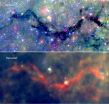(Press-News.org) Around 16,000 people in Switzerland suffer a stroke every year. Often the result of a sudden occlusion of a vessel supplying the brain, it is the most frequent live-threatening neurological disorder. In most cases, it has far-reaching consequences for survivors. Often the stroke sufferers have to cope with handicaps and rehabilitation is a long process. The brain does, however, have a "considerable capacity for regeneration" explains Lukas Bachmann from the Brain Research Institute of the University of Zurich. As member of Professor Martin Schwab's research team, he found that the brainstem, the oldest region in the brain, could play an important role in recovery. The results have now been published in "The Journal of Neuroscience".
The healthy half of the brain assumes control
A stroke in the cerebral cortex frequently leads to motor constraints of one half of the body, to what is known as hemiparesis. This is due to the loss of neuron pathways which transmit signals from the cortex to the spinal cord. As these pathways are crossed, the side of the body contralateral to the affected half of the brain is affected. The major impairments at the beginning are often only temporary and stroke sufferers can sometimes stage an amazing recovery. "The side of the body affected is increasingly controlled by the ipsilateral side of the cortex, i.e. the healthy side", explains Lukas Bachmann. As the neuron pathways are crossed, this raised the following question for the neuroscientists: by which pathway are the signals rerouted from the motor cortex to the ipsilateral parts of the spinal cord?
Sprouting of neurons from the brainstem
In their study in mice the researchers in Martin Schwab's team now demonstrate that the brainstem probably plays a key role in the rerouting of neural impulses. Images of the brain show that after a major stroke nerve fibers from specific core regions of the brain sprout into the area of the spinal cord that had lost its input after a stroke. "At the same time, more fibers sprout from the intact cortex into these same regions of the brainstem", continues Lukas Bachmann. These changes in the neuronal circuits may mediate the non-crossed flow of nerve impulses after a stroke. "This could turn out to be a key mechanism which facilitates recovery after a stroke", says the brain researcher. The scientists now want to use these findings to steer the sprouting of neurons in various areas of the brain by means of targeted therapy to maximise the recovery of motor functions.
INFORMATION: END
Brainstem discovered as important relay site after stroke
2014-02-26
ELSE PRESS RELEASES FROM THIS DATE:
More intensive radiotherapy is better than less for localized prostate cancer
2014-02-26
A radiotherapy regime involving higher doses of radiation is a better option than having lower doses for men with localised prostate cancer, the 10-year results of the largest trial of its kind have shown.
Having 37 rounds, or fractions, of radiotherapy at 74 Gray (Gy) – compared with 32 fractions at 64 Gy – controlled the disease more effectively and reduced the chance that men would need follow-up hormone-deprivation therapy, which can have long-term side-effects.
The findings, published in The Lancet Oncology today (Wednesday), come from the major RT01 phase III ...
Skin cancer risk may have driven evolution of black skin
2014-02-26
Early humans may have evolved black skin to protect against a very high risk of dying from ultraviolet light (UV)-induced skin cancer, a new analysis concludes.
Skin cancer has usually been rejected as the most likely selective pressure for the development of black skin because of a belief that it is only rarely fatal at ages young enough to affect reproduction.
But a new paper, published in Proceedings of the Royal Society B, cites evidence that black people with albinism from parts of Africa with the highest UV radiation exposure, and where humans first evolved, almost ...
Smithsonian scientists solve 'sudden death at sea' mystery
2014-02-26
Mass strandings of whales have puzzled people since Aristotle. Modern-day strandings can be investigated and their causes, often human-related, identified. Events that happened millions of years ago, however, are far harder to analyze—frequently leaving their cause a mystery. A team of Smithsonian and Chilean scientists examined a large fossil site of ancient marine mammal skeletons in the Atacama Desert of Northern Chile—the first definitive example of repeated mass strandings of marine mammals in the fossil record. The site reflected four distinct strandings over time, ...
Brain cell activity regulates Alzheimer's protein
2014-02-26
Increased brain cell activity boosts brain fluid levels of a protein linked to Alzheimer's disease, according to new research from scientists at Washington University School of Medicine in St. Louis.
Tau protein is the main component of neurofibrillary tangles, one of the hallmarks of Alzheimer's disease. It has been linked to other neurodegenerative disorders, including frontotemporal dementia, supranuclear palsy and corticobasal degeneration.
"Healthy brain cells normally release tau into the cerebrospinal fluid and the interstitial fluid that surrounds them, but ...
SMA unveils how small cosmic seeds grow into big stars
2014-02-26
New images from the Smithsonian's Submillimeter Array (SMA) telescope provide the most detailed view yet of stellar nurseries within the Snake nebula. These images offer new insights into how cosmic seeds can grow into massive stars.
Stretching across almost 100 light-years of space, the Snake nebula is located about 11,700 light-years from Earth in the direction of the constellation Ophiuchus. In images from NASA's Spitzer Space Telescope it appears as a sinuous, dark tendril against the starry background. It was targeted because it shows the potential to form many massive ...
Follow-up care for older breast cancer survivors needs to be all-encompassing
2014-02-26
Older women who have overcome breast cancer are likely to struggle with heart disease, osteoporosis and hypertension further on in their lives. Whether these conditions occur or not is influenced by the treatment that patients received to fight cancer, their overall weight and their age. Breast cancer survivors therefore should watch their weight and get regular exercise so that they can enjoy a high quality of life. These findings, by lead author Nadia Obi of the University Medical Center Hamburg-Eppendorf, who collaborated with the group of Prof. Chang-Claude from the ...
New research indicates causal link between vitamin D, serotonin synthesis and autism
2014-02-26
February 26, 2014 - Oakland, CA – A new study by Rhonda Patrick, PhD and Bruce Ames, PhD of Children's Hospital Oakland Research Institute (CHORI) demonstrates the impact that Vitamin D may have on social behavior associated with Autism Spectrum Disorder (ASD). Dr. Patrick and Dr. Ames show that serotonin, oxytocin, and vasopressin, three brain hormones that affect social behavior, are all activated by vitamin D hormone. Autism, which is characterized by abnormal social behavior, has previously been linked to low levels of serotonin in the brain and to low vitamin D levels, ...
Beaumont study: Gamma Knife helps patients with painful facial nerve disorder
2014-02-26
Research by Beaumont Health System radiation oncologists and neurosurgeons found that symptoms of trigeminal neuralgia, or TN, a nerve disorder causing severe facial pain, were reduced in those treated with Gamma Knife stereotactic radiosurgery. The results were published in the February issue of the journal Clinical Neurology and Neurosurgery.
TN is a disorder of the trigeminal nerve, which is responsible for feeling in the face. In most cases, the facial pain is caused by a blood vessel pressing on the nerve. It is believed that TN is caused by deterioration of the ...
Reproductive coercion, intimate partner violence prevalent
2014-02-26
Enough women experience reproductive coercion – male behavior to control contraception and pregnancy outcomes – that a research team now recommends health care providers address the subjects with their patients and tailor family planning discussions and recommendations accordingly.
Researchers from Women & Infants Hospital of Rhode Island were part of a team that published "Reproductive coercion and co-occurring intimate partner violence in obstetrics and gynecology patients" in a recent issue of the American Journal of Obstetrics and Gynecology.
"Reproductive coercion, ...
Artificial muscles that do the twist
2014-02-26
In the heart, as in the movies, 3D action beats the 2D experience hands down.
In 3D, healthy hearts do their own version of the twist. Rather than a simple pumping action, they circulate blood as if they were wringing a towel. The bottom of the heart twists as it contracts in a counterclockwise direction while the top twists clockwise. Scientists call this the left ventricular twist—and it can be used as an indicator of heart health.
The heart is not alone. The human body is replete with examples of soft muscular systems that bend, twist, extend, and flex in complex ...



